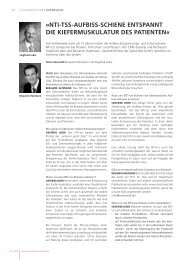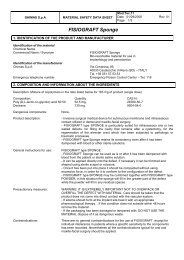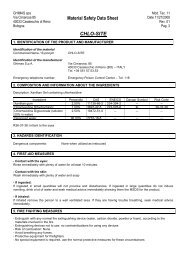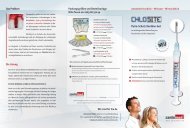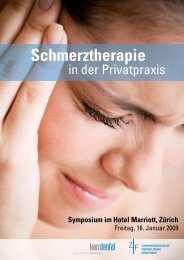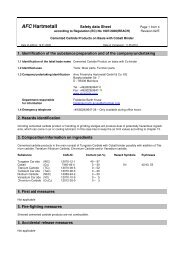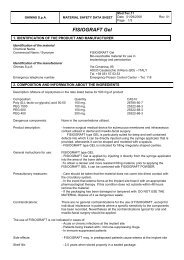USE OF PLA-PGA (COPOLYMERISED POLYLACTIC ... - Zantomed
USE OF PLA-PGA (COPOLYMERISED POLYLACTIC ... - Zantomed
USE OF PLA-PGA (COPOLYMERISED POLYLACTIC ... - Zantomed
You also want an ePaper? Increase the reach of your titles
YUMPU automatically turns print PDFs into web optimized ePapers that Google loves.
<strong>USE</strong> <strong>OF</strong> <strong>PLA</strong>-<strong>PGA</strong> (<strong>COPOLYMERISED</strong> <strong>POLYLACTIC</strong>/POLYGLYCOLIC<br />
ACIDS) AS A BONE FILLER:<br />
CLINICAL EXPERIENCE AND HISTOLOGIC STUDY <strong>OF</strong> A CASE<br />
Stancari F. *, Zanni B. *, Bernardi F. *, Calandriello M. *, Salvatorelli G. **<br />
* Dental School - University of Bologna - Department of Periodontology, Director Prof. Marcello<br />
Calandriello<br />
**Director of the Department of Histology and Cytology - University of Ferrara<br />
Running head: <strong>PLA</strong>-<strong>PGA</strong> AS A BONE FILLER<br />
Abstract<br />
This study describes our preliminary experience on the use of a new polylactic/polyglycolic<br />
copolymer used as a bone filler. In 30 post-extraction and periodontal cases the synthetic material<br />
proved to be extremely easy to handle thanks to the various forms available (sponge, powder and<br />
gel) which adapt well to the various cases which require filling with subsequent formation of new<br />
bone.<br />
The clinical and radiographic show that the new biomaterial is biocompatible, non-allergenic and did<br />
not produce an inflammatory response.<br />
In one clinical case the histological findings demonstrate that, on completion of healing, the<br />
biopolymer is totally replaced by trabecular bone; between the trabeculae it is possible to observe<br />
spaces containing adipose cells and vascular cells, indicating the formation of medulla ossium.<br />
These results were confirmed by electronic microscopy.<br />
Key words<br />
Bone defects, osseous repair, bone filler<br />
Introduction<br />
Current periodontal surgery sometimes<br />
requires the use of bone grafts (autologous<br />
and/or allogenic) to provide structural support<br />
during healing of the bone and to replace<br />
damaged or diseased tissue. In the case of<br />
allografts, there is however a risk of cross<br />
infections (hepatitis, BSE, etc.), while<br />
autologous grafts, particularly if extensive, are<br />
associated with a risk of surgical problems<br />
and post-operative complications at the donor<br />
site.<br />
In light of the above, synthetic materials are<br />
used with increasing frequency in clinical<br />
practice. The literature describes a vast range<br />
of fillers used to repair bone defects and<br />
synthetic bioabsorbable polymers represent<br />
one of the principal innovations in the<br />
biomaterial sector (Ashman 1992, Ashman<br />
1993a, Ashman 1993b, Ewers & Lieb-<br />
Skowron 1990, Kulkarny et al. 1971).<br />
Among these, polylactic acid (<strong>PLA</strong>) and<br />
polyglycolic acid (<strong>PGA</strong>) have been used in the<br />
orthopaedic field and in maxillofacial surgery<br />
for more than a decade, proving highly<br />
effective in osteosynthesis studies (Bos et al.<br />
1989, Desilets et al. 1990, Giudice 1993,<br />
Hollinger & Schmitz 1987, Majola 1991,<br />
Manninen et al. 1992, Miettinen et al. 1992,<br />
Paivarinta et al. 1993, Rehm et al. 1994,<br />
Suuronen 1993, Thaller et al. 1992,<br />
Tsckalaloff et al. 1993, Vasenius et al. 1990).<br />
In dentistry, surgical sutures and absorbable<br />
membranes in <strong>PGA</strong> and/or <strong>PLA</strong> acids have<br />
been available for some time for use in guided<br />
tissue regeneration (Robert et al. 1993,<br />
Robert & Frank 1994). However, only in<br />
recent years have absorbable synthetic<br />
biopolymers been used as bone fillers in<br />
periodontology, proving effective stimulants to<br />
bone regeneration in some cases (Lundgren<br />
et al. 1992, Miyamoto & Takaoka 1993, Winet<br />
& Hollinger 1993).<br />
One of the main advantages of these<br />
polymers is their complete biocompatibility:<br />
<strong>PLA</strong> degrades into lactic acid which is then<br />
broken down into water and carbon dioxide in<br />
<strong>USE</strong> <strong>OF</strong> <strong>PLA</strong>-<strong>PGA</strong> (<strong>COPOLYMERISED</strong> <strong>POLYLACTIC</strong>/POLYGLYCOLIC ACIDS) AS A BONE FILLER:<br />
CLINICAL EXPERIENCE AND HISTOLOGIC STUDY <strong>OF</strong> A CASE – published in Quintessenz (Germany) 51, 1, 47-52 (2000)<br />
- page 1 of 8 -
the Krebs cycle (the Krebs cycle is a chain of<br />
biochemical reactions normally present in the<br />
organism in which energy is produced<br />
through the use of glucide precursors), while<br />
<strong>PGA</strong>, on the other hand, is broken down<br />
through a specific enzyme process (Bos et al.<br />
1989a, Bos et al. 1989b, Bos et al. 1991,<br />
Cutright & Hunsuck 1971, Leenslang et al.<br />
1987). In 1994, a new biomaterial ( * ) appeared<br />
on the Italian market, consisting of a<br />
copolymerised polylactic/polyglycolic acid<br />
(<strong>PLA</strong>-<strong>PGA</strong>) and is destined for use as a<br />
synthetic bone filler in oral surgery.<br />
This copolymer has a spongy open-cell<br />
structure enabling it to be colonised by the<br />
osteoblasts. The time taken for it to be<br />
reabsorbed depends on the relative<br />
percentage of the components and it presents<br />
no risks from a biological point of view, being<br />
synthetic and not a human or animal<br />
derivative.<br />
It is available in sponge, powder and gel<br />
form and can be used in dentistry as a filler<br />
according to the operator’s needs in relation<br />
to the characteristics of the utilisation site.<br />
The ratio of <strong>PLA</strong> to <strong>PGA</strong> is 50/50 and different<br />
formulas are available depending on the<br />
excipients used.<br />
The sponge is produced through the<br />
lyophilisation of <strong>PLA</strong>-<strong>PGA</strong> and dextran. Of<br />
considerable consistency, the sponge is<br />
hydrated if necessary and then softened using<br />
physiological solution or blood and inserted in<br />
the recipient site, without being compacted.<br />
The powder is obtained by pulverisation of<br />
the sponge. Powder and sponge are normally<br />
used together to fill infra-bony pouches,<br />
extraction sockets or other bone defects<br />
where the material can be held in place via a<br />
flap.<br />
The gel is a new formula for synthetic filler<br />
material and is especially suitable for filling<br />
irregular cavities where a flap is unable to<br />
close the defect completely. This is due to the<br />
greater intrinsic stability of the gel inside the<br />
recipient site. The gel is injected directly into<br />
the defect using the syringe provided.<br />
Our clinical experience<br />
In the light of the application potential<br />
described above, the new biomaterial was<br />
* FISIOGRAFT (Ghimas Spa, Bologna)<br />
assessed at the Periodontology Department<br />
of the University of Bologna in thirty clinical<br />
cases where the common aim was to obtain<br />
new bone deposits.<br />
Although a rigid experimental protocol was not<br />
adopted, these first thirty cases represented a<br />
clinical investigation, in particular into the<br />
flexibility and ease of handling of the three<br />
forms of the product and the results obtained.<br />
The study involved 17 males and 13 females<br />
aged between 29 and 66:<br />
• 18 undergoing periodontal surgery: 2<br />
associated with the use of resorbable<br />
membrane (Paroguide); 1 with the use of<br />
non-resorbable membrane (Gore);<br />
• 10 undergoing post-extraction filling: 1<br />
associated with the use of resorbable<br />
membrane (Vycril);<br />
• 2 undergoing implant surgery: 1 with use of<br />
resorbable membrane (Paroguide); 1 with<br />
the use of non-resorbable membrane<br />
(Gore).<br />
In all these cases the defect was filled with an<br />
appropriate quantity of Fisiograft, choosing the<br />
powder formulation in 9% of the cases, the<br />
sponge formulation in 27% and the gel<br />
formulation in 64%; in some cases the<br />
various formulations were used together.<br />
Each case was photographed and monitored<br />
over a period of time both from a clinical point<br />
of view and via intraoral radiographs. Within<br />
the limits due to the possibility of comparing<br />
radiographs taken at different times but with a<br />
standardised technique, the radiological<br />
images were used to indicate the degree of<br />
filling of the defect as:<br />
R=0 no filling<br />
R=1 filling less than 50%<br />
R=2 filling more than 50%<br />
R=3 total filling.<br />
<strong>USE</strong> <strong>OF</strong> <strong>PLA</strong>-<strong>PGA</strong> (<strong>COPOLYMERISED</strong> <strong>POLYLACTIC</strong>/POLYGLYCOLIC ACIDS) AS A BONE FILLER:<br />
CLINICAL EXPERIENCE AND HISTOLOGIC STUDY <strong>OF</strong> A CASE – published in Quintessenz (Germany) 51, 1, 47-52 (2000)<br />
- page 2 of 8 -
Figure 1 - Variation in the filling of the bone defect from<br />
the radiographs taken at 3, 6 and 12 months, in the<br />
cases undergoing periodontal surgery. R=0 No Filling,<br />
R=1 Filling less than 50%, R=2 Filling more than 50%,<br />
R=3 Total filling<br />
Figures 1 and 2 show the results obtained:<br />
progressively higher bone filling can be noted<br />
in the post-extraction cases, in any case<br />
satisfactory in both clinical cases.<br />
The state of physiological reaction present<br />
immediately after the operation rapidly<br />
regressed over the subsequent days, without<br />
any patient being prescribed specific antiinflammatory<br />
treatment. There were no cases<br />
of inflammatory relapse after the week<br />
following the operation.<br />
As confirmation of the favourable results<br />
obtained in this study, the deposition of new<br />
bone was assessed objectively in a number<br />
of cases through histologic examination of<br />
core samples taken during implant<br />
operations.<br />
As an example, one of these cases is<br />
described below.<br />
Figure 3 - Cavity of the upper left premolar with<br />
complete absence of the vestibular wall<br />
Figure 2 - Variation in the filling of the bone defect from<br />
the radiographs taken at 3, 6 and 12 months, in the<br />
cases undergoing extraction (10 cases) and implants<br />
(2 cases)<br />
Case report<br />
The observations relate to a particularly<br />
compromised left upper premolar in a 45year-old<br />
female patient.<br />
This tooth had already been unsuccessfully<br />
treated endodontically with a retrograde and<br />
orthograde approach. X-ray examination<br />
showed a periapical osteolysis with a<br />
diameter of about 5 mm.<br />
It was decided to extract the tooth and insert<br />
an appropriate quantity of Fisiograft into the<br />
cavity. The sponge formula was chosen for its<br />
compact consistency, making it suitable for<br />
filling large cavities.<br />
A muco-periosteum flap was created enabling<br />
the biomaterial used as a bone filler to be<br />
protected and retained in place.<br />
The following procedures were carried out at<br />
the same time as the extraction:<br />
1. curettage of the cavity where the vestibular<br />
wall was found to be completely lacking<br />
(fig. 3);<br />
2. creation of inductive perforations to<br />
encourage new bone deposition;<br />
3. positioning of sponge-type Fisiograft<br />
suitably hydrated with sterile physiological<br />
solution (fig. 4);<br />
Figure 4 - Positioning of sponge-type Fisiograft after<br />
appropriate hydration<br />
4. positioning on top of this of a absorbable<br />
polyglycolic membrane (Vycril mesh),<br />
<strong>USE</strong> <strong>OF</strong> <strong>PLA</strong>-<strong>PGA</strong> (<strong>COPOLYMERISED</strong> <strong>POLYLACTIC</strong>/POLYGLYCOLIC ACIDS) AS A BONE FILLER:<br />
CLINICAL EXPERIENCE AND HISTOLOGIC STUDY <strong>OF</strong> A CASE – published in Quintessenz (Germany) 51, 1, 47-52 (2000)<br />
- page 3 of 8 -
5. covering of the cavity with a muco-gingival<br />
flap and stabilisation with loop sutures;<br />
6. a first X-ray examination of the site<br />
immediately after positioning of the<br />
biomaterial (fig. 5a). The alveolus presents<br />
with a maximum level of radio<br />
transparency due to the fact that the<br />
biomaterial itself is not radiopaque;<br />
The sutures were removed 7 days after the<br />
operation.<br />
X-ray controls were carried out at 4.5 months<br />
and at 8 months (fig. 5b and 5c). The<br />
radiograph taken at 4.5 months shows neotrabeculum<br />
bone which appears to be greater<br />
at the apical portion. In the radiograph taken at<br />
8 months the formation of the neoformed<br />
bone is almost completed and it has<br />
progressed to the coronal region. These<br />
radiograph sequences show progressive<br />
opacification of the graft site which are<br />
common findings for the healing process<br />
involving a healthy post extraction alveolus. In<br />
this case there were only three residual walls,<br />
which in the absence of the biomaterial would<br />
have resulted in a drastic reduction of the final<br />
bucco-lingual width. Instead the results<br />
appear to be optimal for the introduction of a<br />
prosthetic implant.<br />
Nine months after the operation an access<br />
flap was cut exposing the newly formed<br />
mineralised tissue, identical to bone tissue<br />
(fig. 6). During the operation, a core sample of<br />
tissue was taken (suitably fixed with buffered<br />
formalin) and sent for histologic examination<br />
to confirm the clinical observation.<br />
Figure 5a - Intra-oral X-ray of the site after positioning<br />
of the biomaterial. The alveolus presents with a<br />
maximum level of radio transparency this is due to the<br />
fact that the biomaterial is not radiopaque<br />
Figure 5b - Intra-oral X-ray of the site after 4 and a half<br />
months. The radiograph shows neotrabeculum bone<br />
which appears to be greater at the apical portion.<br />
Figure 5c - Intra-oral X-ray of the site after 8 months.<br />
Here the formation of the neoformed bone is almost<br />
completed and it has progressed to the coronal<br />
region.<br />
Histologic examination<br />
On biopsy, the material removed appeared to<br />
consist of well-mineralised lamellar bone with<br />
the characteristics of normal alveolar bone.<br />
Internal spaces were observed containing<br />
connective tissue and blood vessels (fig. 7)<br />
(evidence of the presence of active bone<br />
tissue repair and reconstruction phenomena).<br />
Figure 6 - Exposure of the newly formed tissue after 9<br />
months: the presence of a newly formed layer of bone<br />
is evident, suitable for implant<br />
<strong>USE</strong> <strong>OF</strong> <strong>PLA</strong>-<strong>PGA</strong> (<strong>COPOLYMERISED</strong> <strong>POLYLACTIC</strong>/POLYGLYCOLIC ACIDS) AS A BONE FILLER:<br />
CLINICAL EXPERIENCE AND HISTOLOGIC STUDY <strong>OF</strong> A CASE – published in Quintessenz (Germany) 51, 1, 47-52 (2000)<br />
- page 4 of 8 -
Figure 7.- Histological analysis of the biopsy<br />
specimen showed well-mineralised lamellar bone,<br />
with the characteristics of normal alveolar bone.<br />
Internal spaces can be seen containing connective<br />
tissue and blood vessels.<br />
As confirmation of the normal anatomic<br />
situation, there were numerous osteons<br />
present in the bone tissue structure<br />
consisting of concentric lamellae arranged<br />
around the haversian canals. Between these,<br />
were numerous bone cavities containing<br />
osteocytes. In a number of areas, the<br />
presence of interstitial lamellae, the residue of<br />
earlier generations of osteocytes, indicate that<br />
a previous reorganisation of bone tissue had<br />
already taken place.<br />
Microscopic observation showed no trace of<br />
the implanted material, inflammatory infiltrate<br />
or foreign-body granulomas which would have<br />
demonstrated the incompatibility of the<br />
material.<br />
Figures 8 and 9 At electron microscopy the haversian<br />
canals are lined with bone progenitor cells. The<br />
ground substance contains bundles of collagen fibrils<br />
with regular alternating light and dark bands. They are<br />
parallel to each other within the individual lamellae,<br />
but neighbouring lamellae have different orientations.<br />
The specimen appears to be well mineralised, as<br />
shown by the presence of numerous hydroxyapatite<br />
crystals in the structure of the collagen fibre bundles,<br />
and cellularised by elements identifiable as<br />
osteocytes (magnification fig. 8 x 9,000; fig. 9 x 6,000).<br />
The examination concentrated in particular on<br />
ascertaining the absence of the lymphocytes,<br />
macrophages, plasma cells, giant cells and<br />
mast cells always present in cases of chronic<br />
inflammation.<br />
Fine structure electron microscope analysis<br />
further confirmed the optical microscope<br />
observations (fig. 8 and 9).<br />
The haversian canals were lined with bone<br />
progenitor cells. The ground substance<br />
contained bundles of collagen fibrils with<br />
regular alternating light and dark bands. They<br />
were parallel to each other within the<br />
individual lamellae, but neighbouring lamellae<br />
had different orientations. The specimen<br />
appeared to be well mineralised, as shown by<br />
the presence of numerous hydroxyapatite<br />
crystals in the structure of the collagen fibre<br />
bundles, and cellularised by elements<br />
identifiable as osteocytes.<br />
Discussion<br />
The synthetic copolymer used in these cases<br />
proved to be extremely easy to handle as a<br />
result of the various forms available (sponge,<br />
powder and gel) which easily adapt to the<br />
various cases requiring use of a filler with<br />
subsequent formation of new bone.<br />
The use of Fisiograft with resorbable<br />
membranes was found to give optimum<br />
results.<br />
<strong>USE</strong> <strong>OF</strong> <strong>PLA</strong>-<strong>PGA</strong> (<strong>COPOLYMERISED</strong> <strong>POLYLACTIC</strong>/POLYGLYCOLIC ACIDS) AS A BONE FILLER:<br />
CLINICAL EXPERIENCE AND HISTOLOGIC STUDY <strong>OF</strong> A CASE – published in Quintessenz (Germany) 51, 1, 47-52 (2000)<br />
- page 5 of 8 -
Clinical and instrumental data obtained from<br />
these cases showed that the new biomaterial<br />
was biocompatible, non-allergenic and did not<br />
produce an inflammatory response,<br />
confirming the data contained in literature<br />
(Hollinger 1983, Meikle et al. 1994, Vert et al.<br />
1994, Winet & Hollinger 1993).<br />
It should be emphasised that due to its<br />
synthetic origin, there is a complete absence<br />
of biological risk.<br />
The histologic findings showed that the<br />
copolymer remained in the site of the graft<br />
until completion of the natural healing<br />
processes. At the same time it is penetrated<br />
and gradually and totally replaced by<br />
trabecular bone.<br />
Between the trabeculae, there are spaces<br />
containing adipose and vascular cells<br />
indicating the formation of medulla ossium<br />
(Schakenraad & Dijkstra 1991, Winet &<br />
Hollinger 1993). Previous studies in animals<br />
and humans indicate that total absorption<br />
occurs about four months after placement of<br />
the graft (Leghissa et al. 1997, Saitoh et al.<br />
1994) with a histologic profile comparable to<br />
that noted in the clinical case described<br />
above.<br />
One of the uses which appears most<br />
promising in the future is the possibility of<br />
adding bone growth factors to the polylactic/<br />
polyglycolic copolymer. Initial experiments<br />
(Miyamoto et al. 1992, Miyamoto & Takaoka<br />
1993, Miyamoto et al. 1993) show that the<br />
copolymer serves as an excellent carrier for<br />
these factors.<br />
Our experience gives grounds for optimism<br />
regarding the future of this synthetic bone<br />
replacement biomaterial, which demonstrated<br />
osteoconductivity, considerable<br />
practical flexibility and excellent<br />
biocompatibility. The results obtained<br />
represent a valid premise for further studies to<br />
confirm the product’s efficiency in stimulating<br />
bone growth.<br />
<strong>USE</strong> <strong>OF</strong> <strong>PLA</strong>-<strong>PGA</strong> (<strong>COPOLYMERISED</strong> <strong>POLYLACTIC</strong>/POLYGLYCOLIC ACIDS) AS A BONE FILLER:<br />
CLINICAL EXPERIENCE AND HISTOLOGIC STUDY <strong>OF</strong> A CASE – published in Quintessenz (Germany) 51, 1, 47-52 (2000)<br />
- page 6 of 8 -
References<br />
• Ashman. A. (1992) Clinical applications of<br />
synthetic bone in dentistry. Part 1 General<br />
Dentistry 40. 481-487<br />
• Ashman. A. (1993a) Clinical applications of<br />
synthetic bone in dentistry. Part 2 General<br />
Dentistry 41. 37-44<br />
• Ashman. A. (1993b) Synthetic bone<br />
material as particulate matter in<br />
conjunction with endosseous implants.<br />
Dental Implantology Update 4. 17-21<br />
• Bos. R.R.M., Rozema. F.R., Boering. G.,<br />
Nijenhuis. A.J., Pennings. A.J. & Verwey.<br />
A.B. (1989a) Bio-absorbable plates and<br />
screws for internal fixation of mandibular<br />
fractures. A study in six dogs. International<br />
Journal of Oral & Maxillofacial Surgery 18.<br />
365-369<br />
• Bos. R.R.M., Rozema. F.R., Boering. G.,<br />
Nijenhius. A.J., Penning. A.J. & Janshen.<br />
H.W.B. (1989b) Bone plates and screw of<br />
bioadsorbable poly(L-lactide): an animal<br />
study. British Journal of Oral &<br />
Maxillofacial Surgery 27. 467-489<br />
• Bos. R.R.M., Rozema. F.R., Boering. G.,<br />
Nijenhuis. A.J., Penning. A.J., Verwey. A.B.<br />
Nieuwenhuis. P. & Janshen. H.W.B. (1991)<br />
Degradation of and tissue reaction to<br />
biodegradable poly(L-lactide) for use as<br />
internal fixation of fractures: a study in rat.<br />
Biomaterials 12. 32-36<br />
• Cutright. D.E. & Hunsuck. E.E. (1971):<br />
Tissue reaction to the biodegradable<br />
polylactic acid suture. Oral Surgery Oral<br />
Medicine Oral Pathology 31. 134-139<br />
• Desilets. C.P., Marden. L.J., Patterson.<br />
A.L. & Hollinger. J.O. (1990) Development<br />
of a synthetic bone-repair materials for<br />
craniofacial reconstruction. Journal of<br />
Craniofacial Surgery 1. 150-153<br />
• Ewers. R. & Lieb-Skowron. J. (1990)<br />
Bioadsorbable osteosynthesis materials.<br />
Facial Plastic Surgery 7. 206-214<br />
• Giudice. M., Colella. G. & Marra. A. (1993)<br />
Applicazioni cliniche dei biomateriali.<br />
Minerva Stomatologica 42. 399-342<br />
• Hollinger. J.O. (1983) Preliminary report on<br />
the osteogenic potential of a biodegradable<br />
copolymer of polylactide (<strong>PLA</strong>) and<br />
polyglycolide (<strong>PGA</strong>). Journal of Biomedical<br />
Materials Research 17. 71-82<br />
• Hollinger. J.O. & Schmitz. J.P. (1987)<br />
Restoration of bone discontinuities in dogs<br />
using a biodegradable implant. Journal of<br />
Oral & Maxillofacial Surgery. 45. 594-600<br />
• Kulkarny. R.K., Moore. E.G., Hegyeli. A.F.<br />
& Leonard. F. (1971) Biodegradable<br />
polylactic acid polymers. Journal<br />
Biomedical Materials Research 5. 169-181<br />
• Leenslang. J.W., Penning. A.J., Bos.<br />
R.R.M., Rozema. F.R. & Boering. G.<br />
(1987) Resorbable materials of poly(Llactide).<br />
In vivo and in vitro degradation.<br />
Biomaterials 8. 70-73<br />
• Leghissa. G.C., Salvatorelli. G., Gulinati.<br />
A.M., Anzanel. D. & Marchetti. M.G. (1997)<br />
Un nuovo materiale per la rigenerazione<br />
ossea guidata. Dentista Moderno 6. 77-85<br />
• Lundgren. D., Nyman. S., Mathisen. T.,<br />
Isaksson. S. & Klinge. B. (1992) Guided<br />
bone regeneration of cranial defects, using<br />
biodegradable barriers: an experimental<br />
pilot study in the rabbit. Journal of<br />
Craniomaxillofacial Surgery 20. 257-260<br />
• Majola. A. (1991) Fixation of experimental<br />
osteotomies with absorbable polylactic<br />
acid screws. Annales Chirurgiae et<br />
Gynaecologiae 80. 274-281<br />
• Manninen. M.J., Paivarinta. U., Taurio. R.,<br />
Tormala. P., Suuronen. R., Raiha. J.,<br />
Rokkanen. P. & Patiala. H. (1992)<br />
Polylactide screws in the fixation of<br />
osteotomies. A mechanical study in sheep.<br />
Acta Orthopaedica Scandinavica 63. 437-<br />
442<br />
• Meikle. M.C., Papaioannou. S., Ratledge.<br />
T.J., Speight. P.M., Watt-Smith. S.R., Hill.<br />
P.A. & Reynolds. J.J. (1994) Effect of poly<br />
DL-lactide-co-glycolide implants and<br />
xenogeneic bone matrix-derived growth<br />
factors on calvarial bone repair in the<br />
rabbit. Biomaterials 15. 513-521<br />
• Miettinen. H., Makela. E.A., Vainio. J.,<br />
Rokkanen. P. & Tormala. P. (1992) The<br />
effect of an intramedullary self-reinforced<br />
poly-L-lactide (SR-PLLA) implant on<br />
growing bone with special reference to<br />
fixation properties. An experimental study<br />
on growing rabbits. Journal of Biomaterial<br />
Science Polymers Ed. 3. 443-450<br />
• Miyamoto. S., Takaoka. K., Okada. T.,<br />
Yoshikawa. H., Hashimoto. J., Suzuki. S. &<br />
<strong>USE</strong> <strong>OF</strong> <strong>PLA</strong>-<strong>PGA</strong> (<strong>COPOLYMERISED</strong> <strong>POLYLACTIC</strong>/POLYGLYCOLIC ACIDS) AS A BONE FILLER:<br />
CLINICAL EXPERIENCE AND HISTOLOGIC STUDY <strong>OF</strong> A CASE – published in Quintessenz (Germany) 51, 1, 47-52 (2000)<br />
- page 7 of 8 -
Ono. K. (1992) Evaluation of polylactic acid<br />
homopolymers as carriers for bone<br />
morphogenetic protein. Clinical<br />
Orthopaedics and Related Research 278.<br />
274-285<br />
• Miyamoto. S., Takaoka. K., Okada. T. &<br />
Yoshikawa. H. (1993) Polylactic acidpolyethylene<br />
glycol block copolymer. A new<br />
biodegradable synthetic carrier for bone<br />
morphogenic protein (BMP). Clinical<br />
Orthopaedics and Related Research 294.<br />
333-342<br />
• Miyamoto. S. & Takaoka. K. (1993) Bone<br />
induction and bone repair by composites of<br />
bone morphogenetic protein and<br />
biodegradable synthetic polymers. Annales<br />
Chirurgiae et Gynaecologiae Suppl. 207.<br />
69-75<br />
• Paivarinta. U., Bostman. O., Toivonen. T.,<br />
Tormala. P. & Rokkanen. P. (1993)<br />
Intraosseous cellular response to<br />
biodegradable fracture fixation screws<br />
made of polyglycolide or polylactide.<br />
Archives Orthopedic Trauma Surgery 112.<br />
71-74<br />
• Rehm. K.E., Helling. H.J. & Claes. L.<br />
(1994) Bericht der arbeitsgruppe<br />
biodegradable implantate. Aktuelle<br />
Traumatologie 24. 70-73<br />
• Robert. P.M. & Frank. R.M. (1994)<br />
Periodontal guided tissue regeneration with<br />
a new reasorbable polylactic acid<br />
membrane. Journal of Periodontololgy 65.<br />
414-421<br />
• Robert. P.M., Maudit. J., Frank. R.M. &<br />
Vert. M. (1993) Biocompatibility and<br />
resorbability of a reasorbable polylactic<br />
acid membrane for periodontal guided<br />
tissue regeneration. Biomaterials 14. 353-<br />
358<br />
• Saitoh. H., Takata. T., Nikau. H., Shintani.<br />
H., Hyon. S.H. & Ikada. Y. (1994) Tissue<br />
compatibility of polylactic acids in the<br />
skeletal site. Journal of Materials Science:<br />
Materials in Medicine 5. 194-199<br />
• Schakenraad. J.M. & Dijkstra. P.J. (1991)<br />
Biocompatibility of poly(DL-lactic acid/<br />
glycine) copolymers. Clinical Materials 7.<br />
253-167<br />
• Suuronen. R. (1993) Biodegradable<br />
fracture-fixation devices in maxillofacial<br />
surgery. International Journal of Oral &<br />
Maxillofacial Surgery 22. 50-57<br />
• Thaller. S.R., Huang. V. & Tesluk. H.<br />
(1992) Use of biodegradable plates and<br />
screws in a rabbit model. Journal<br />
Craniofacial Surgery 2. 168-173<br />
• Tsckalaloff. A., Losken. H.W., Lalikos. J.,<br />
Link. J., Mooney. M.P., von Oepen. R.,<br />
Michaeli. W. & Losken. A. (1993)<br />
Experimental studies of DL-polylactic acid<br />
biodegradable plates and screws in<br />
rabbits: computed tomography and<br />
molecular weight loss. Journal of<br />
Craniofacial Surgery 4. 223-227<br />
• Vasenius. J., Vainionpaa. S., Vihtonen. K.,<br />
Mero. M., Makela. A., Tormala. P. &<br />
Rokkanen. P. (1990) A histomorphological<br />
study on self-reinforced polyglycolide (SR-<br />
<strong>PGA</strong>) osteosynthesis implants coated with<br />
slowly absorbable polymers. Journal of<br />
Biomedical Materials Research 24. 1615-<br />
1635<br />
• Vert. M., Li. S.M. & Garreau. H. (1994)<br />
Attempts to map the structure and<br />
degradation characteristics of aliphatic<br />
polyesters derivated from lactic and<br />
glycolic acids. Journal of Biomaterial<br />
Science Polymers Ed. 6. 639-649<br />
• Winet. H. & Hollinger. J.O. (1993)<br />
Incorporation of polylactide/polyglycolide in<br />
a cortical defect: neoosteogenesis in a<br />
bone chamber. Journal of Biomedical<br />
Materials Research 27. 667-676<br />
<strong>USE</strong> <strong>OF</strong> <strong>PLA</strong>-<strong>PGA</strong> (<strong>COPOLYMERISED</strong> <strong>POLYLACTIC</strong>/POLYGLYCOLIC ACIDS) AS A BONE FILLER:<br />
CLINICAL EXPERIENCE AND HISTOLOGIC STUDY <strong>OF</strong> A CASE – published in Quintessenz (Germany) 51, 1, 47-52 (2000)<br />
- page 8 of 8 -






